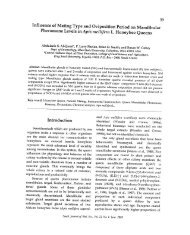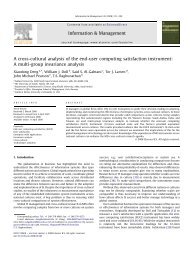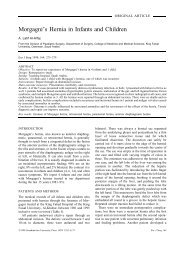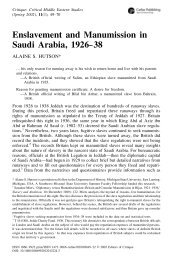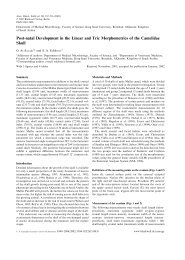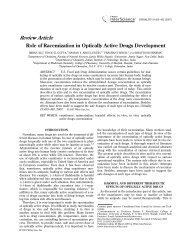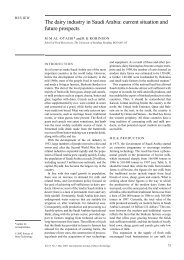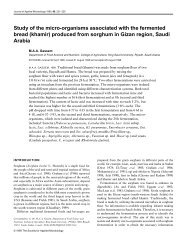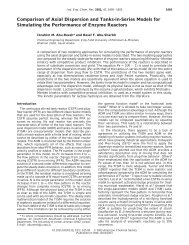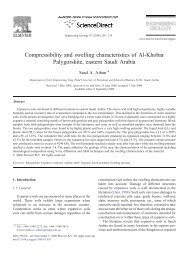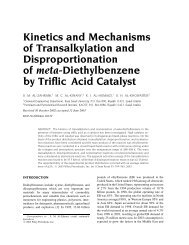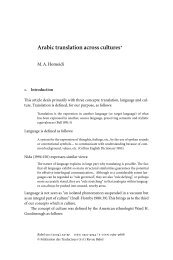The Influence of Alumina on the Performance of FCC Catalysts ...
The Influence of Alumina on the Performance of FCC Catalysts ...
The Influence of Alumina on the Performance of FCC Catalysts ...
You also want an ePaper? Increase the reach of your titles
YUMPU automatically turns print PDFs into web optimized ePapers that Google loves.
<strong>Performance</strong> <str<strong>on</strong>g>of</str<strong>on</strong>g> <strong>FCC</strong> <strong>Catalysts</strong> Energy & Fuels, Vol. 17, No. 1, 2003 67<br />
Table 6. MAT Products Yields for VGO Cracking at C/O ) 3 for Catalyst CAT0, CAT5, CAT10, and CAT20<br />
compound name CAT0 yield (wt %) CAT5 yield (wt %) CAT10 yield (wt %) CAT20 yield (wt %)<br />
H2 0.02 0.03 0.06 0.09<br />
C1 0.22 0.34 0.36 0.42<br />
C2 0.18 0.27 0.28 0.3<br />
C2 ) 0.34 0.45 0.42 0.45<br />
dry gas (H2+C1+C2+C2 ) ) 0.76 1.09 1.12 1.26<br />
C3 0.51 0.74 0.73 0.76<br />
C3 ) 4.96 5.91 5.63 5.63<br />
i-C4 3.91 5.13 4.77 4.85<br />
n-C4 0.57 0.78 0.75 0.78<br />
t2-C4 ) 2.08 2.34 2.23 2.18<br />
1-C4 ) 1.58 1.77 1.71 1.66<br />
i-C4 ) 2.02 1.94 1.94 1.88<br />
c2-C4 ) 1.57 1.77 1.69 1.65<br />
total C4 ) 7.25 7.82 7.56 7.37<br />
total C4 (olefins + paraffins) 11.73 13.74 13.08 13<br />
LPG (total C3 +total C4) 17.2 20.39 19.44 19.38<br />
gasoline 50.8 52.29 50.82 51.63<br />
LCO 18.57 16.04 17.79 17.09<br />
HCO 11.33 8.2 9.06 8.39<br />
coke 1.34 1.93 1.77 2.24<br />
total 100 99.94 100 100<br />
c<strong>on</strong>versi<strong>on</strong>) 100 - (LCO wt % + HCO wt %) 70.1 75.8 73.2 74.5<br />
Figure 7. <str<strong>on</strong>g>The</str<strong>on</strong>g> effect <str<strong>on</strong>g>of</str<strong>on</strong>g> alumina additi<strong>on</strong> <strong>on</strong> dry gas selectivity.<br />
9 0 wt % alumina (CAT0). 0 5 wt % alumina (CAT5), 4<br />
10 wt % alumina (CAT10), and × 20 wt % alumina (CAT20).<br />
in processes such as <strong>FCC</strong>. 17 <str<strong>on</strong>g>The</str<strong>on</strong>g> present results agree<br />
with above arguments (see Figures 6 and 7). Table 6<br />
reports <strong>the</strong> product distributi<strong>on</strong> for <strong>FCC</strong> catalysts.<br />
<str<strong>on</strong>g>The</str<strong>on</strong>g> effect <str<strong>on</strong>g>of</str<strong>on</strong>g> alumina additi<strong>on</strong> <strong>on</strong> light olefin selectivity<br />
is shown in Figure 8. Light olefin selectivity is<br />
defined as <strong>the</strong> total gas olefin (C2-C4) yield divided by<br />
VGO c<strong>on</strong>versi<strong>on</strong>. It can be seen that alumina additi<strong>on</strong><br />
has c<strong>on</strong>tributed to a mild increase in <strong>the</strong> product<br />
olefinicity. <str<strong>on</strong>g>The</str<strong>on</strong>g>se results are in agreements with <strong>the</strong><br />
argument that alumina additi<strong>on</strong> might increase olefin/<br />
paraffin ratio due to <strong>the</strong> increased cracking over hydrogen<br />
transfer reacti<strong>on</strong> ratio. 16<br />
Taking <strong>the</strong> role <str<strong>on</strong>g>of</str<strong>on</strong>g> coke in <strong>FCC</strong> unit into c<strong>on</strong>siderati<strong>on</strong>,<br />
Mott 20 introduced <strong>the</strong> c<strong>on</strong>cept <str<strong>on</strong>g>of</str<strong>on</strong>g> “dynamic activity”<br />
which is defined as <strong>the</strong> sec<strong>on</strong>d-order c<strong>on</strong>versi<strong>on</strong> [c<strong>on</strong>versi<strong>on</strong>/(100<br />
- c<strong>on</strong>versi<strong>on</strong>)] divided by coke yield (wt %).<br />
It was found that a plot <str<strong>on</strong>g>of</str<strong>on</strong>g> coke wt % versus <strong>the</strong> sec<strong>on</strong>d<br />
order c<strong>on</strong>versi<strong>on</strong> gives a straight line with a slope equal<br />
to <strong>the</strong> reciprocal <str<strong>on</strong>g>of</str<strong>on</strong>g> catalyst dynamic activity (<strong>the</strong> specific<br />
coke) as shown in Figure 9. <strong>Catalysts</strong> with high dynamic<br />
activity have better performance at commercial c<strong>on</strong>diti<strong>on</strong>s.<br />
For each catalyst, (with different alumina c<strong>on</strong>tent)<br />
<strong>the</strong> graphs were plotted and a slope (reciprocal <str<strong>on</strong>g>of</str<strong>on</strong>g><br />
Figure 8. <str<strong>on</strong>g>The</str<strong>on</strong>g> effect <str<strong>on</strong>g>of</str<strong>on</strong>g> alumina additi<strong>on</strong> <strong>on</strong> light olefin (C2-<br />
C4) selectivity. 9 0 wt % alumina (CAT0). 0 5 wt % alumina<br />
(CAT5), 4 10 wt % alumina (CAT10), and × 20 wt % alumina<br />
(CAT20).<br />
dynamic activity) was obtained for each alumina c<strong>on</strong>tent.<br />
It is extremely important that <strong>the</strong> relati<strong>on</strong>ship<br />
between <strong>the</strong> VGO sec<strong>on</strong>d-order c<strong>on</strong>versi<strong>on</strong> and coke<br />
yield is linear at <strong>FCC</strong> c<strong>on</strong>diti<strong>on</strong>s. 20 For <strong>the</strong> base catalyst<br />
(CAT0), <strong>the</strong> dynamic activity was 1/(0.391) ) 2.56 while<br />
for those catalysts c<strong>on</strong>taining alumina was 1/(0.5771)<br />
) 1.73. Thus although alumina additi<strong>on</strong> to <strong>FCC</strong> catalyst<br />
matrix has increased <strong>the</strong> catalyst activity as shown in<br />
Figure 2, it decreased its dynamic activity. Usually<br />
dynamic activity parameter is more important than<br />
activity parameter. 20<br />
Figure 9 shows that CAT0 with inactive matrix has<br />
higher dynamic activity than CAT20 with active matrix.<br />
This result is expected, since alumina increases coke<br />
formati<strong>on</strong>. Thus it can be c<strong>on</strong>cluded that <strong>FCC</strong> catalyst<br />
acidity can be increased by incorporating alumina or by<br />
increasing Y-zeolite unit cell size. 6,7 Increasing <strong>the</strong>se<br />
factors leads to a decrease in <strong>the</strong> catalyst dynamic<br />
activity. 6,7 However, increasing alumina has better



